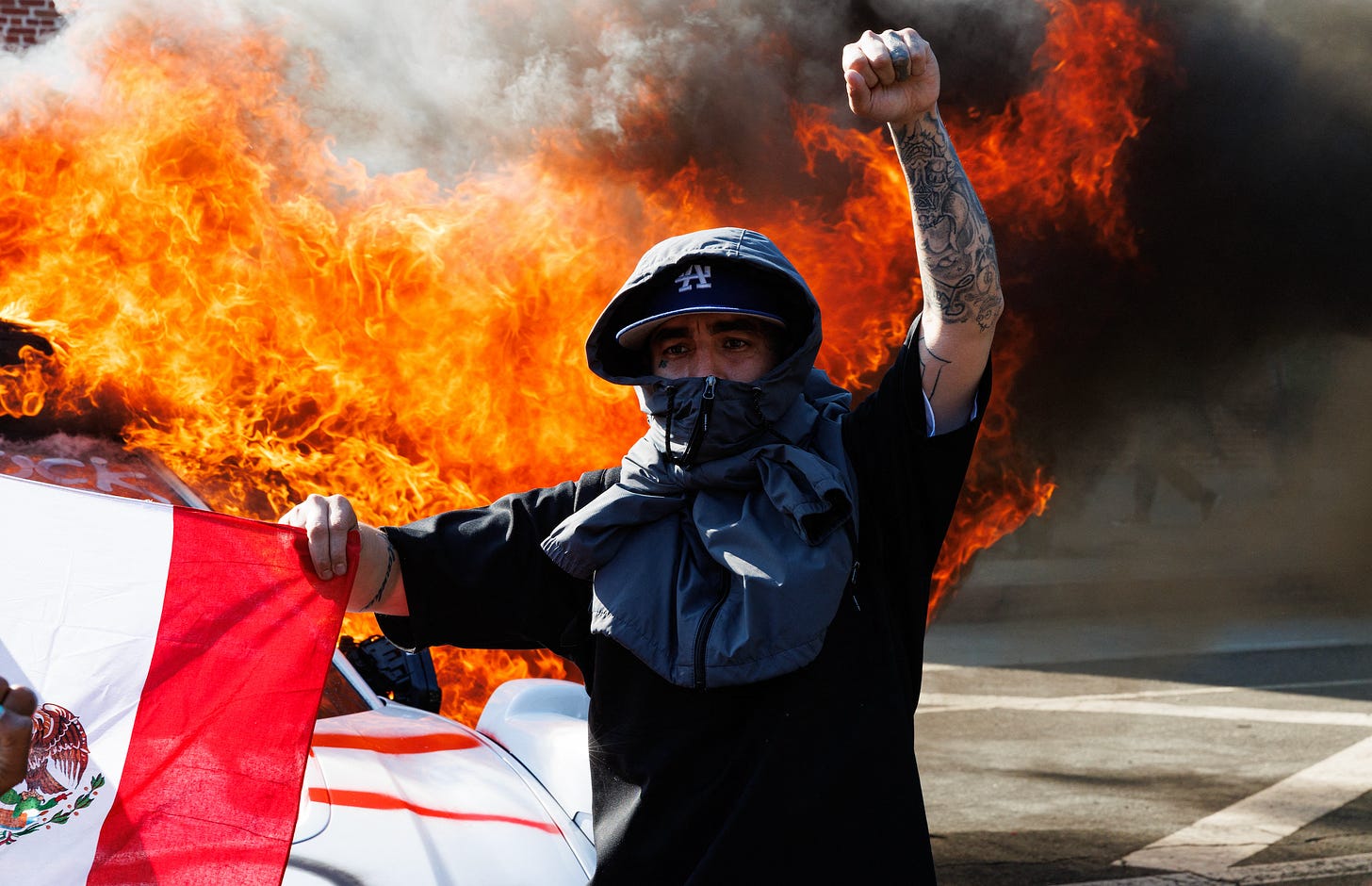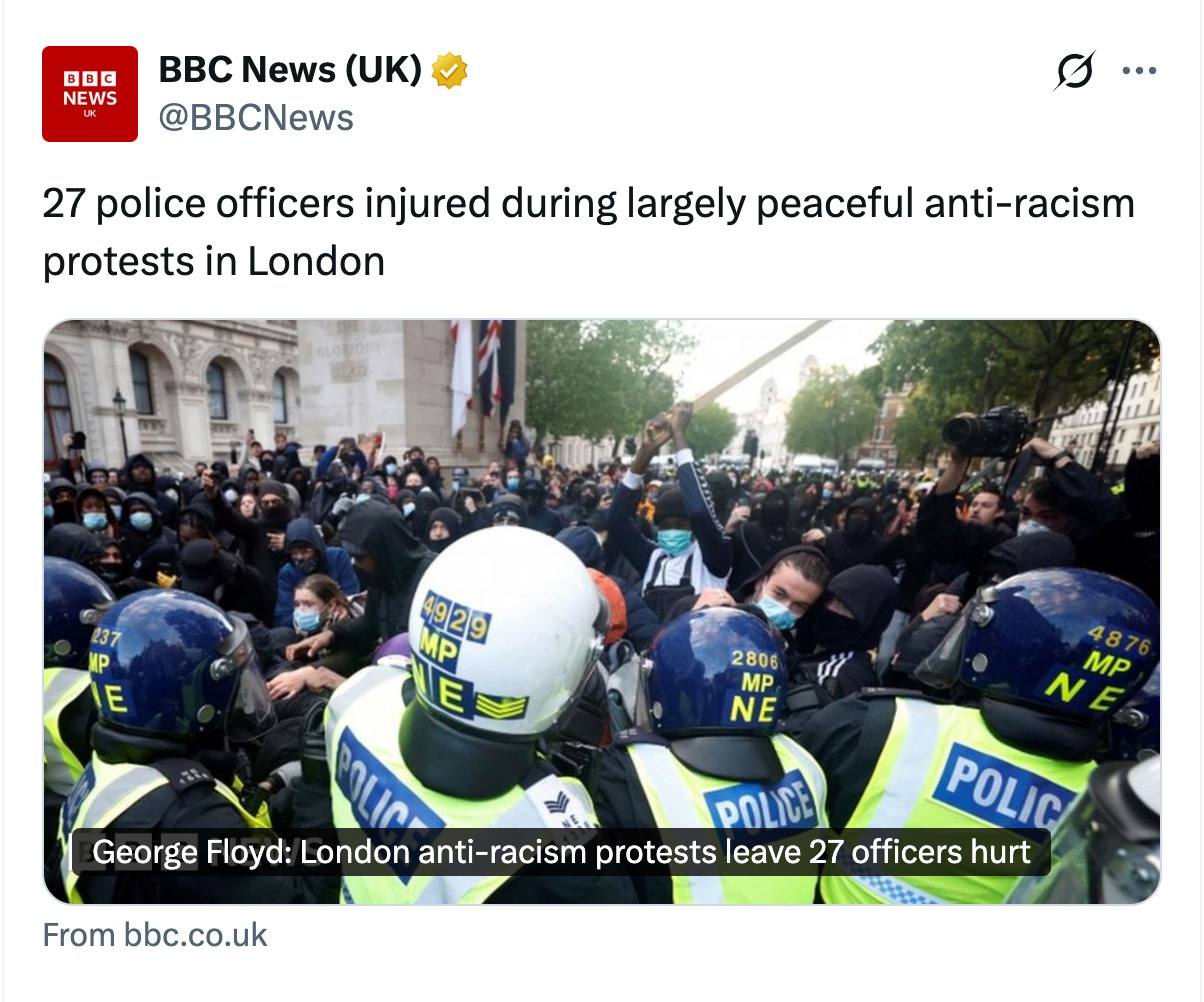The "Mostly Peaceful" Revolution
The Los Angeles riots are reviving the revolting homages to Marx and socialist revolution that helped elect Donald Trump in the first place
Almost exactly five years ago, on June 6th, 2020, protests erupted in Britain after the killing of George Floyd. Thousands hit the streets in London, Manchester, Nottingham, Wolverhampton, and Bristol, in demonstrations that included toppling statues, blocking the M6 freeway, and in London, hurling flares and rolling bicycles at police. The BBC headline described “largely peaceful” protests:
“Mostly peaceful protest” didn’t enter the cultural lexicon as an iconic media absurdity until months later, when poor CNN reporter Omar Jimenez did a standup in front of a burning building above the immortal chyron, “FIERY BUT MOSTLY PEACEFUL PROTESTS AFTER POLICE SHOOTING.” CNN posterized Jimenez twice, as he was also onscreen with Wolf Blitzer when the word “violent” disappeared from a tagline mid-broadcast. Most mainstream observers defended the oxymoronic approach, hailing a September 2020 study that mathematically characterized the mostly-peacefulness of that summer’s protests (93%!) while arguing the public should be focused on greater violence-s of racism, colonialism, police brutality, etc.
The current Los Angeles riots have revived “mostly peaceful” in a big way. American officials and commentators are avoiding the infamous “mostly” construction and returning with “largely peaceful” (New York Times), “overwhelmingly peaceful” (a rebranded “Kamala D. Harris”) or just “peaceful protests” (Cory Booker). Go overseas, though, or down a peg to the don’t-give-a-damn tier of propagandists, and you’ll see “mostly peaceful” back word-for-word.
This episode’s coverage hysterics (lowlights below) have somehow already lapped the Summer of Floyd. Once again, the public is being trained in distinctions between illegitimate and legitimate protest, regressive force versus righteous resistance. You can agree with it or not, but anyone who’s been to college knows what this is, and we should stop trying to hide it:
“Apparel manufacturers” and a Home Depot were raided by ICE Friday in what the New York Times called an “immigration raid.” Border Czar Tom Homan said they were executing warrants for money laundering and other offenses and it wasn’t a “routine” immigration raid. Either way, it triggered protests led in part by the SEIU, whose leader David Huerta was “assaulted and arrested” (he tried to block a law enforcement van and was pushed back), in turn leading to the ongoing “clashes.” Trump signed a memo greenlighting deployment of 2,000 National Guardsmen Saturday, protesters threw “rocks, glass bottles and fireworks” at local police and dropped “rocks and trash” on “unoccupied” police cars, while officers “took cover” under an overpass. Three people were reportedly “trampled and injured” by police on horseback, and the Times explained that three driverless Waymo taxis (magically?) “caught on fire.”
By Sunday night, in a repeat of the Floyd story, protests were planned across the country. This is the critical part of every Trump news cycle. Instead of accepting political reality (Trump got elected, Trump nominated a judge, Trump got elected again, Trump started executing a promised immigration policy), press and elected opposition rally behind protests that are encouraged to spread everywhere, not-so-subtly pining for an administration-toppling Disorder Event, even if we just had an election. The same national security experts who ten seconds ago wanted to tear up the Constitution to stop “extremism” or “authoritarianism” now say throwing rocks at cops or burning shit is “legal protest” with a “little unrest,” the First Amendment with a citrus twist of revolt. Usual Suspects like John Heilemann pop up to tell us there’s nothing to see here, just people chanting “This is what democracy looks like!” in front of burning vehicles.
This is the moment when the previously disinterested voter looks up, notices governors and mayors and congresspersons expressing apparently limitless support for illegal immigration, tax evasion, even crime, and wonders what the deal is. As in, a civilian protester can hold signs saying “No one is illegal” or “Abolish ICE Now” or even wave the Mexican flag on seized highways, but officials who command police forces or are charged with immigration enforcement probably shouldn’t cheer — unless they harbor utopian notions about a borderless world, which they inevitably do because they went to college in America. This zone of realization is where Trump cleans up every time. I used to think it was unfortunate, now I think it’s deserved. These idiots can’t muster the energy to even pretend to care at even a baseline level about mundane patriotic concerns like not letting absolutely everyone over the border, or drawing some kind of line when it comes to vandalism or school standards. Even the most liberal voter reaches a moment of exhaustion with this bullshit.
When Trump was elected in 2017, immigration for him was an open political wound, with just -21% approval. He’s currently at +1%, a 22-point swing. That’s similar to the massive voter shift on education, for ages a safe Democratic stronghold (Trump has lost support on education since inauguration among college Republicans, but still). In both cases voters broadcasted that they fear lefty radicalism more than Trumpian reaction, but no one listened. Just as the public is still told legitimate frustrations about the educational system are ignorant prole fear of “teaching about slavery,” they’re told anger about years of olé border control are xenophobic and unreasonable. Moderates would likely run back to Democrats if they would just act uncomfortable at the sight of masked protesters raising fists in front of walls of flames. You can be sympathetic to Gazans without actually wanting America to be Gaza. But people can sense the secret stiffy lefties get at this imagery.
At the time of the protests after George Floyd’s death I’d only just published a book on police abuse and was hopeful the subject would get the right kind of attention. Activists and demonstrators instead made clear they were aiming at bigger targets. A sweeping campaign commenced against structural racism, systemic racism, interpersonal racism, colonialism, Washington, Jefferson, Teddy Roosevelt (and other Presidents Until Obama), “Black Pete” the blackface helper of Dutch Santa Claus, the pride of “little England,” whiteness, the “white narrative of conservation,” and a billion other things. It was an international clarion call to expunge all political evils, in the heart, at home (“Your Bookshelf May Be Part of the Problem”), everywhere.
“Mostly peaceful” grew out of an attempt to fix newsrooms. Editors were long conscious of the “worthy and unworthy victims” problem posed by Noam Chomsky in Manufacturing Consent. Chomsky correctly noted that in 1980s America victims of Communist violence received buckets more coverage than victims of U.S. client states. The classic example was one murdered Polish priest versus “a hundred religious victims in Latin America.” Being politically aware meant applying proper balance. So far so good, but editors who worried that audiences might think burning buildings are worse than police murder began thumbing the scale. “Mostly Peaceful” was an inverse of “Police Kill Burglary Suspect,” which also nudged toward a conclusion. The new thing was far more openly manipulative, though, in part because CNN, BBC, NPR, etc. were only halfway to the eventual message.
The Summer of Floyd introduced the phenomenon of elite-encouraged violence. We saw professors talking about “violence as a social lubricant,” read studies from Harvard’s Belfer Center explaining that the effectiveness of MLK-style civil disobedience had “begun to decline,” saw National Public Radio publish “In defense of looting,” and watched the crazy tale of political scientist David Shor, who was first denounced for “anti-blackness,” then fired after tweeting a study suggesting violence was ineffective and might help re-elect Trump. Embracing the Marcusean saw that the only “actual violence” was to start applying ethics “at the point where the oppressed rebel against the oppressors,” this was an extension of a debate that consumed lefties since the 1999 Battle of Seattle, when a handful of campus theorists wondered if a smaller handful of anti-WTO protesters helped or hurt “the movement” by smashing a few Starbucks storefronts.
If you came of political age in the nineties or early 2000s, listening to this was like a bad acid flashback (I was once warned by an editor under pain of dismissal never to use that simile, but it’s true here). The Shor episode was the worst because it was such a perfect echo of every dingbat pseudo-intellectual confab from American campus life, when even as a generally left-leaning person I felt like stabbing myself with a fork anytime anyone mentioned politics. The assumption was a) all rational people lived on the socialist spectrum and b) the proletariat a.k.a. ordinary people only “voted against their interests” because they were misinformed. Once things were properly explained (by us, of course), they’d jump on the revolutionary train. If they didn’t, that just meant consumerism had “weakened the rationality of protest” for the working class, and the revolution would need to be fronted by double-persecuted demographics like People of Color or immigrants.
In 2020, anyone short of an outright Marxist had to be able to see that Shor was right. Burning bank branches and small businesses and stealing 50 cars at a time was clearly not going to be popular. The chattering classes then made things worse first by denying any of this was happening, then by implying that if it was happening, only certain people were allowed to be annoyed (“Riots That Followed Anti-Racism Protests Come At Great Cost To Black-Owned Businesses” was NPR’s take). It was political suicide, unless you weren’t really interested in winning votes.
It was also impossible not to notice the endless machinations over terminology, which only people of a certain ideological orientation can listen to without screaming. In America we were constantly updated on new acronyms for victim classes, while in Britain the “reckoning” included widespread use of BAME, for “Black and Minority Ethnic.” Last year I saw an Independent story about how BAME was being switched out for “Global Majority.” The latter is more accurate if you’re counting the global population, but not so much if you’re dealing with single countries, which a sizable percentage of college-educated people obviously think are anachronisms, like certain kinds of speech and voting.
This has been made clear repeatedly, through episodes like Brexit (when a majority desire to remain a country was dismissed as illegitimate) and in the current furious partisan battles in places like Germany and America over immigration (when votes to tighten borders are similarly dismissed). Over and over, to a degree people like Stephen A. Smith keep warning will backfire, Democratic politicians choose intellectual fashion over governance. They refuse to listen to voters, which forces voters to punish them, out of fear they won’t listen at all if returned to power.
I imagine I’m not alone in feeling trapped between two political brands outside my comfort zone. Trump is in office in significant part because the goofball principles of the last “mostly peaceful” revolution made the majority want to puke its guts out. Why run it back? Are there really no other ideas?



Amazing that no Dem other than John Fetterman (!) can see this and make a clear distinction between protest and anarchy.
Says a lot about the Dems.
The public scratches its collective head as protesting illegals wave the flags of countries they don’t want to return to.